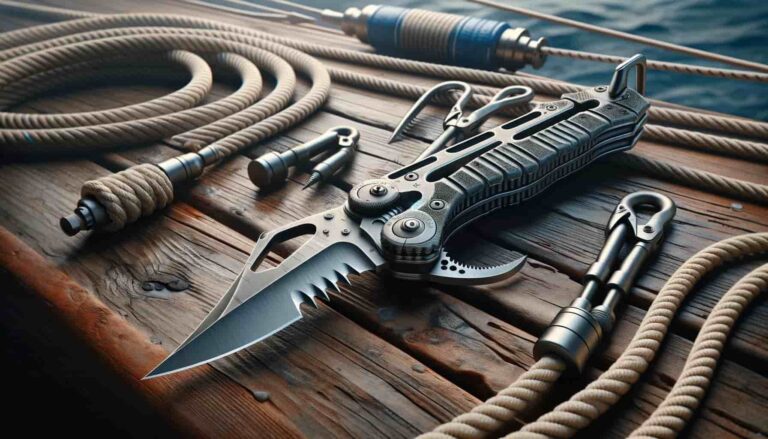How To Sail A Catamaran
So you’ve got your hands on a catamaran and you’re eager to set sail? Well, you’ve come to the right place. In this article, we’ll provide you with all the necessary tips and tricks to navigate your catamaran with confidence and skill. From understanding the unique characteristics of a catamaran to mastering the art of sail trim, we’ll cover it all. Whether you’re a seasoned sailor looking to try something new or a beginner ready to embark on your first catamaran adventure, this guide is here to help you make the most of your time on the water. So, grab your sunscreen, hop on board, and let’s dive into the world of catamaran sailing!

Understanding the Basics of a Catamaran
Recognizing a Catamaran
A catamaran is a type of boat that consists of two parallel hulls of equal size. Unlike traditional sailboats that have a single hull, a catamaran offers stability and increased maneuverability on the water. One of the easiest ways to recognize a catamaran is by its unique design, with two hulls situated side by side. This design not only provides a spacious deck area but also glides smoothly over the water, making it a popular choice for sailing enthusiasts.
Key Features and Components
To better understand a catamaran, it’s essential to familiarize yourself with its key features and components. Some of the prominent features include the two parallel hulls, which typically have a shallow draft, allowing the boat to navigate in shallower waters. The deck area is usually spacious, providing ample seating and storage options. Additionally, catamarans often have a trampoline net between the two hulls, creating a perfect spot for lounging or basking in the sun.
Key components of a catamaran include the mast, boom, and sails. The mast is the tall, vertical structure that supports the sails. The boom is a horizontal spar attached to the bottom of the mast, providing additional support to the mainsail. The mainsail is the primary sail that catches the wind and powers the boat forward. In addition to the mainsail, catamarans may also have jib sails that provide extra propulsion.
Advantages of a Catamaran
Catamarans offer several advantages over traditional monohull sailboats. One significant advantage is their stability. Due to the wider hulls, catamarans have a much lower center of gravity, making them less prone to tipping over or heeling excessively in the wind. This stability provides a comfortable and safe sailing experience, especially for those prone to seasickness.
Another advantage of a catamaran is its speed. The parallel hulls reduce drag, allowing the boat to move swiftly through the water. This speed not only increases efficiency but also allows for quicker passage times, making it an excellent choice for those looking to cover more distance in less time.
Additionally, catamarans offer a spacious and open deck area, providing ample room for socializing, sunbathing, and storing equipment. The trampoline netting between the hulls is a favorite spot for relaxation, offering a unique experience of being both close to the water and the breeze above.
Potential Challenges of a Catamaran
While catamarans have many advantages, they also come with a few potential challenges. Their wide beam can make docking and maneuvering in tight spaces more challenging compared to monohull sailboats. It’s essential to become proficient in handling a catamaran to overcome this initial learning curve.
Additionally, due to their larger size, catamarans may require more careful navigation in shallower waters to avoid running aground. The shallow draft makes them suitable for cruising in places with limited depth, but it’s crucial to remain vigilant and consult nautical charts to ensure safe passage.
Lastly, catamarans can be more expensive to purchase and maintain compared to monohull sailboats. The additional hull, rigging, and equipment required for a catamaran contribute to higher costs. However, the benefits and unique sailing experience they offer often outweigh these financial considerations.
Preparing for Sailing
Safety Equipment Checklist
Before setting sail, it is crucial to ensure that you have all the necessary safety equipment on board your catamaran. A comprehensive safety equipment checklist includes life jackets for all passengers, a properly functioning marine VHF radio, distress flares, a first aid kit, a fire extinguisher, and navigation lights. It is also essential to have a throwable flotation device, such as a lifebuoy or horseshoe buoy, readily accessible in case of emergencies.
Weather Conditions and Forecast
Monitoring weather conditions is of utmost importance before embarking on any sailing adventure. Pay close attention to wind speed, wave height, and weather forecasts to ensure safe sailing conditions. It is recommended to check local weather channels, consult with experienced sailors, and use reliable weather apps or websites specifically designed for sailors. Understanding the weather conditions will help you plan your route accordingly and make informed decisions during your journey.
Planning the Route
Planning the route is a crucial step in preparing for a sailing trip on your catamaran. Consider factors such as your sailing experience, the duration of the trip, and the locations you wish to visit. Take into account prevailing winds, currents, and potential hazards, such as shallow waters or rocky areas. Plotting your course on nautical charts and identifying safe anchorages along the way will ensure a smooth and enjoyable journey.
Understanding Basic Sailing Terms
To sail a catamaran efficiently, it is essential to understand basic sailing terms. Familiarize yourself with terms such as tack, jibe, port, starboard, windward, leeward, and points of sail. Understanding these terms will enable clear and effective communication with your crew and ensure proper maneuvering of your catamaran. Take the time to learn these terms and their meanings to enhance your overall sailing experience.
Rigging Your Catamaran
Step by Step Process of Rigging
Rigging your catamaran correctly is essential for safe and efficient sailing. Here is a step-by-step process to guide you through the rigging procedure:
-
Start by attaching the standing rigging to the mast and deck fittings, ensuring that all connections are secure.
-
Raise the mast by using a halyard and tension the rigging appropriately to ensure stability.
-
Attach the boom to the gooseneck fitting on the mast and secure it with a boom vang or topping lift.
-
Hoist the mainsail, ensuring that it is properly attached to the mast’s track or slugs and check for any twists or tangles.
-
Rig the jib or headsail by attaching it to the forestay and adjusting the halyard tension to achieve the desired sail shape.
-
Check all lines and sheets for proper tension and ensure they are correctly cleated or controlled by winches.
-
Finally, make a thorough inspection of all rigging components to ensure everything is secure and in working order before setting sail.
Important Parts to Focus On
When rigging your catamaran, it is crucial to pay attention to key components to ensure a safe and successful sail. Start by checking the standing rigging, including the shrouds and forestay, for any signs of wear or damage. Inspect the mast for any cracks or corrosion and verify that all fittings and connections are secure.
The boom and gooseneck fitting should be inspected to ensure proper attachment, and the boom vang or topping lift should be in good condition to provide sufficient support to the boom. Additionally, inspect the sails for any tears, fraying, or worn-out sections, and replace or repair as necessary. Finally, check all lines, sheets, and halyards for wear, proper tension, and smooth operation.
Common Rigging Mistakes to Avoid
While rigging your catamaran, it is essential to be aware of common mistakes to avoid any mishaps or accidents. Some common rigging mistakes include:
-
Over-tightening the rigging: This can cause excessive strain on the mast and rigging components, potentially leading to failure or damage.
-
Failure to secure fittings properly: Loose or improperly secured fittings can detach while sailing, jeopardizing safety and potentially causing damage to the rigging.
-
Neglecting to inspect lines and sheets: Over time, lines and sheets can wear out, become frayed, or lose their strength. Regular inspections can help identify potential problems before they lead to equipment failure.
-
Incorrect sail trim: Improperly trimmed sails can affect the boat’s speed, stability, and overall performance. Understanding how to adjust the sails properly will maximize your catamaran’s sailing capabilities.
By being mindful of these common rigging mistakes and taking the time to rig your catamaran correctly, you can ensure a safer and more enjoyable sailing experience.
Launching Your Catamaran
Ideal Locations for Launching
Choosing the ideal location for launching your catamaran is an important consideration to ensure a smooth and safe start to your sailing adventure. Look for a designated boat ramp or marina with appropriate facilities and support services. A location with calm and protected waters is preferable, as it reduces the risk of encountering rough conditions during the launching process. Additionally, consider the presence of any submerged obstacles or shallow areas that could impede your launch.
Launching Techniques
Mastering the launching techniques will help you navigate the process with confidence. Here is a simple step-by-step guide to launching your catamaran:
-
Before launching, ensure that all necessary safety equipment is on board and easily accessible, and conduct a final check of the rigging, sails, and lines.
-
Back your trailer down the boat ramp, ensuring that the catamaran is floating but still secured to the trailer.
-
Untie the catamaran from the trailer and disconnect any remaining lines or straps.
-
Push the catamaran off the trailer into the water, ensuring that it floats freely and doesn’t run aground.
-
Use a paddle or oar to maneuver away from the boat ramp and into deeper water, taking care to avoid any other vessels or obstacles.
-
Once you have cleared the immediate area and are in safe and deep water, start the engines (if applicable) or hoist the sails and begin your sailing adventure.
Helpful Tips for a Smooth Launch
To ensure a smooth and hassle-free launch, here are some helpful tips to keep in mind:
-
Arrive early: Arriving at the boat ramp or marina early allows you to avoid crowds and gives you ample time to prepare your catamaran and check all equipment.
-
Communicate with others: If there are other boaters waiting to launch or retrieve their boats, maintain clear communication to minimize congestion and ensure everyone’s safety.
-
Practice launching techniques: Before your actual launch, practice launching and retrieving your catamaran in a controlled environment, such as an empty parking lot or a designated practice area.
-
Consider wind and current conditions: Assess the prevailing wind and current conditions to anticipate potential challenges during the launching process. It may be necessary to seek assistance from other boaters or enlist the help of a boatyard operator for a safe launch.
By following these tips and being well-prepared, you can enjoy a smooth and successful launch, setting the stage for an incredible sailing experience on your catamaran.

Operating Your Catamaran
Steering Mechanisms
Catamarans are typically steered using a steering wheel or tiller connected to the rudder system. The rudders, located at the back of each hull, are responsible for controlling the direction of the boat. When using a steering wheel, turning it clockwise or counterclockwise will move the rudders and, in turn, change the boat’s heading. When using a tiller, moving it to the left or right will have the same effect.
It is essential to familiarize yourself with the responsiveness and handling characteristics of your catamaran’s steering system. Practice making small adjustments to get a feel for how the boat reacts, especially when maneuvering through tight spaces or in varying wind conditions.
Managing the Sail
Managing the sail on a catamaran involves several key techniques to ensure efficient sailing and control of the boat’s speed and direction. Here are a few important aspects to consider:
-
Sail Trim: Adjusting the sails correctly is crucial to optimize their efficiency. Use the main sheet to control the angle of the mainsail in relation to the wind. The correct trim will generate maximum power and speed while minimizing drag.
-
Reefing: When the wind picks up or conditions become challenging, reefing the sails can help reduce their surface area and prevent overpowering. This involves securing a reef line to lower the mainsail or partially roll in the headsail. Practice reefing techniques regularly to ensure confidence and efficiency.
-
Sail Shape: Understanding how to shape the sails properly allows you to adapt to different wind conditions. Adjust the halyard tension and using the cunningham or outhaul controls to achieve the desired sail shape and keep the boat balanced and controllable.
Experiencing Different Wind Conditions
Sailing a catamaran provides the opportunity to experience a variety of wind conditions, each requiring a different approach to ensure a safe and enjoyable journey. Here are a few wind conditions you may encounter and how to navigate them:
-
Light Winds: In light winds, it is crucial to make the most of the available breeze. Utilize light-air sailing techniques such as pointing higher to catch any wind, trimming sails precisely, and avoiding excessive maneuvers that may slow the boat down.
-
Moderate Winds: As winds increase, the boat will start to heel slightly. Adjust the sails and the angle of the boat relative to the wind to maintain a comfortable balance. This may involve depowering the sails by reefing or adjusting the sail trim, ensuring the boat remains under control.
-
Strong Winds: When faced with strong winds, it is crucial to reef the sails early to prevent overpowering and maintain stability. Reduce the sail area by securing the mainsail or rolling in the headsail. Keep the boat on a manageable heading and be prepared for gusts by staying focused and ready to adjust the sails as needed.
By adapting your sailing techniques and paying attention to wind conditions, you can confidently navigate your catamaran through varying winds, enjoying the thrill and serenity of sailing in different environments.
The Art of Tacking
What is Tacking?
Tacking refers to a basic sailing maneuver where the bow of the boat crosses into the wind, changing the boat’s direction. This maneuver allows you to sail upwind in a zigzag pattern, making progress towards your destination. Tacking is essential when sailing against the wind and enables you to navigate efficiently by taking advantage of the wind’s angle.
When to Tack
Knowing when to tack is crucial for maintaining speed and making progress towards your destination. In general, you should tack when the boat’s course becomes less effective, primarily due to changing wind direction. By tacking, you can adjust your heading and take advantage of the new wind direction to maintain speed and stay on course.
Pay attention to telltale signs such as the luffing of the sails or a decrease in boat speed. These indications suggest that it is time to tack and change your boat’s angle in relation to the wind.
Steps in Executing a Tack
Executing a tack correctly requires coordination and proper technique. Here are the steps to follow when performing a tack:
-
Prepare the crew: Communicate with your crew, informing them that a tack is about to be executed. Assign specific roles, such as releasing and trimming the sheets, and ensure everyone is wearing the necessary safety equipment.
-
Steer into the wind: Turn the boat’s bow into the wind by steering toward the new desired course. Gradually turn the wheel or tiller while avoiding excessive movements that may cause the boat to stall or lose momentum.
-
Release the jib sheet: The crew member responsible for the jib should release the jib sheet as the bow approaches the wind. This allows the jib to move more freely as the boat completes the tack.
-
Ease the main sheet: The crew member handling the mainsail should ease the main sheet as the bow turns into the wind. This allows the mainsail to swing across the boat smoothly.
-
Cross the wind: As the boat completes the tack and the bow passes through the eye of the wind, the sails will naturally fill on the opposite side. The crew should trim the jib and the mainsail to maintain a proper sail shape.
-
Resume course: Once the tack is complete, steer the boat onto the new course. Trim the sails accordingly to maximize performance and continue sailing towards your destination.
By practicing tacking maneuvers and refining your technique, you will become more proficient in efficiently changing direction while maintaining control of your catamaran.

Jibing Safely
Understanding Jibing
Jibing is a sailing maneuver performed to change the direction of the boat while sailing downwind. Unlike tacking, where the bow crosses the wind, jibing involves turning the stern of the boat through the wind. This maneuver allows the boat to shift from one broad reach to the other and can be employed when sailing with the wind coming from behind.
Difference Between Tacking and Jibing
While both tacking and jibing involve changing the direction of the boat, they differ in the positioning of the wind and the point of sail. Tacking is used to maneuver upwind when the wind is coming from the front of the boat, while jibing is performed downwind when the wind is coming from behind. Understanding the distinction between these maneuvers is crucial for safe and efficient sailing.
Safety Precautions During Jibing
Jibing can be more challenging than tacking due to the forceful movement of the boom. Here are some essential safety precautions to follow during jibing:
-
Communicate with your crew: Before jibing, inform your crew members, assigning roles and ensuring their readiness. Everybody should be aware of and prepared for the maneuver.
-
Prepare the boom: Secure the main sheet by bringing it under control before the jibe. Gradually ease the main sheet until the sail is slack and can move freely across the boat during the jibe.
-
Keep a lookout: Maintain a vigilant awareness of other boats, obstacles, and crew members’ positions while executing the jibe. Ensure there is enough space and that no one is in the way of the boom during the maneuver.
-
Control the boom: As the boat begins to turn through the wind, control the movement of the boom by preventing any sudden or uncontrolled swing. Use the main sheet in a controlled manner to allow the sail to move smoothly across the boat.
-
Maintain balance: Throughout the jibing maneuver, it is crucial to maintain balance and stability on the boat. Shift your weight as necessary to counterbalance the movement and ensure the crew members are braced or holding onto secure handholds.
By adhering to these safety precautions, you can execute jibing maneuvers safely and confidently, enjoying the thrill of sailing downwind while maintaining control of your catamaran.
Mooring and Anchoring
Proper Techniques for Mooring a Catamaran
Mooring a catamaran requires proper techniques and the use of appropriate equipment to ensure the boat remains securely in place. Here are a few essential steps to follow when mooring your catamaran:
-
Approach the mooring site slowly: Reduce your speed as you approach the mooring site to allow for better maneuverability and control over the catamaran.
-
Prepare fenders and lines: Attach fenders to the hulls in areas that will make contact with the mooring buoy. This prevents damage to the boat during the mooring process. Prepare lines, ensuring their lengths are appropriate for the mooring buoy’s distance below the water surface.
-
Approach the mooring buoy carefully: Align your boat with the mooring buoy, taking into account wind and current conditions. Use a boat hook to grab the buoy’s eye or the pickup loop, securing it temporarily to the bow cleat.
-
Secure the catamaran to the mooring: Once the buoy is safely attached to your catamaran, transfer control to the helmsman while you secure the boat using the prepared lines. Cleat the lines or attach them to cleats or winches, ensuring they are taut and secure.
-
Check for secure attachment: Before leaving the catamaran unattended, verify that all lines and attachments are properly secured. Test the lines for tension and make any necessary adjustments to ensure a secure and stable mooring.
Choosing the Right Anchor and Location
Choosing the right anchor and location is crucial for anchoring your catamaran safely and securely. Consider the following factors when selecting an anchor:
-
Anchor type: There are various anchor types available, such as plow, fluke, and claw anchors, each with its advantages and suitability for different seabeds. Research the anchor types and choose one that is appropriate for the conditions you are likely to encounter.
-
Anchor size and weight: The size and weight of the anchor should be suitable for the size and weight of your catamaran. Consult anchor sizing charts or seek advice from experienced sailors to determine the correct anchor size and weight for your specific boat.
-
Anchoring location: Look for a location with suitable bottom conditions, such as sandy or muddy seabeds, which provide good holding. Consider sheltered areas that provide protection from wind, waves, and currents.
-
Check for obstructions: Ensure that there are no underwater obstructions, such as rocks or reefs, in the anchoring location that may damage your catamaran or impede the anchor’s ability to hold.
By selecting the right anchor and choosing an appropriate location, you can anchor your catamaran with confidence, knowing that it will remain securely in place during your stay.
Anchoring Procedure Step by Step
To anchor your catamaran correctly, follow these step-by-step procedures:
-
Select an appropriate anchoring location based on the factors mentioned earlier.
-
Approach the chosen anchorage slowly, considering current and wind conditions.
-
Determine the water depth and the amount of anchor rode (chain and/or line) required. The recommended length is typically 5-7 times the water depth, depending on conditions and local regulations.
-
Prepare the anchor and align the catamaran for anchoring.
-
Gradually lower the anchor over the bow, ensuring it reaches the bottom without tangling or dragging on the catamaran.
-
Let out the desired amount of anchor rode while slowly maneuvering the boat backward to set the anchor.
-
Check that the anchor is firmly set by gradually increasing the tension on the anchor rode. Observe the catamaran’s position in relation to fixed objects onshore or other nearby boats to ensure the anchor’s holding.
-
Once the anchor is set and holding, cleat off the anchor rode or secure it to a winch.
Remember to always monitor the catamaran’s position and the overall anchoring situation, adjusting the anchor rode as necessary to maintain a safe and secure anchorage.

Emergency Procedures to Follow
Dealing with Man Overboard Situation
In the unfortunate event of a man overboard situation, it is crucial to act quickly and efficiently to ensure the safety of the person in the water. Follow these emergency procedures:
-
Notify the crew: Immediately alert the other crew members of the emergency situation, shouting “Man overboard!” to grab their attention.
-
Point and keep eyes on the person overboard: Maintain visual contact with the person in the water and point in their direction to guide the crew’s attention.
-
Engage the engine(s): If your catamaran is equipped with engines, engage them and maneuver the boat toward the person overboard while keeping them in sight.
-
Deploy a floatation device: Throw a throwable floatation device, such as a lifebuoy or life jacket, towards the person in the water to provide support and increase their chances of staying afloat.
-
Use the man overboard recovery procedure: If you have practiced a man overboard recovery procedure, follow it carefully to retrieve the person from the water. This may involve maneuvering the boat around and using a ladder, boarding platform, or disabled engines.
-
Communicate with the person overboard: Give clear instructions to the person in the water, reassuring them and directing them to stay calm and follow any guidance provided.
-
Administer first aid if necessary: Once the person is back on board, assess their condition and provide any necessary first aid or medical attention.
Remember, prevention is key when it comes to man overboard situations. Promote a culture of safety onboard, encourage the use of life jackets, and ensure that crew members are trained in man overboard recovery procedures.
Procedures for a Stranded or Grounded Catamaran
If your catamaran becomes stranded or grounded, it is essential not to panic and take immediate action to ensure the safety of the vessel and its occupants. Follow these steps:
-
Assess the situation: Determine the extent of the stranding or grounding and assess any potential risks or damages. Check for water ingress or shifting tides that could affect the vessel’s stability.
-
Communicate the situation: Notify relevant authorities or the nearest coastguard station of the situation, providing accurate details of your location, the condition of the boat, and the number of people on board.
-
Evaluate options: Consider the available options to free the catamaran, such as waiting for the tide to rise, using auxiliary power, or seeking assistance from neighboring boats or professional salvage services.
-
Safeguard the crew and boat: Ensure that everyone on board is wearing life jackets and secure any loose equipment or belongings. Take measures to prevent further damage to the hull or rigging.
-
Follow professional advice: If professional assistance is required, communicate with the salvage service or authorities, following their guidance and instructions carefully.
-
Document the incident: Take photos or videos of the stranding or grounding, including the surrounding conditions, for insurance and reporting purposes.
Remember, stranding or grounding situations can be dangerous, so prioritize the safety of everyone on board and seek appropriate assistance as soon as possible.
Reacting to Sudden Weather Changes
Sudden weather changes can pose a significant challenge when sailing a catamaran. Here’s how to react to unexpected weather conditions:
-
Monitor weather updates: Stay informed by regularly monitoring weather forecasts and listening to relevant weather channels. Choose reliable sources and use dedicated marine weather apps or websites for accurate and up-to-date information.
-
Identify potential signs: Look out for visual cues that suggest changes in weather conditions, such as darkening skies, increasing wind speed, or sudden temperature shifts. These signs can indicate the need to make adjustments or seek shelter.
-
Secure the boat: In anticipation of adverse weather, prepare the boat by securing loose items, reefing the sails if necessary, and ensuring that all hatches, windows, and doors are closed securely.
-
Assess the situation and take immediate action: If sudden weather changes occur, assess the severity of the situation and make decisions accordingly. Seek shelter in a safe harbor or anchorage if necessary, or adjust the sail plan to ensure the safety of the crew and the boat.
-
Communicate your plans: Notify any relevant parties, such as the coastguard or other boaters in the vicinity, of your changed plans or seek assistance if required.
Remember, it is crucial to prioritize safety over other considerations when faced with sudden weather changes. Make informed decisions based on the current conditions, the capabilities of your catamaran, and the experience level of your crew.
Maintenance of Your Catamaran
Regular Upkeep and Care
Regular upkeep and care are essential to maintain the performance, safety, and longevity of your catamaran. Follow these maintenance practices:
-
Cleanliness: Regularly clean the decks, hulls, and interior of the catamaran to prevent the buildup of grime, salt, or debris that can lead to damage or deterioration.
-
Inspections: Conduct regular inspections to identify any signs of wear or damage, such as cracks, leaks, loose fittings, or worn-out components. Pay close attention to areas prone to stress, such as the rigging, hull-to-deck joints, and sail tracks.
-
Engine maintenance: If your catamaran is equipped with engines, follow the manufacturer’s guidelines for regular maintenance, including oil changes, filter replacements, and overall system checks. Keep up with routine maintenance to avoid costly repairs and ensure reliable performance.
-
Electrical and plumbing systems: Inspect and maintain the electrical and plumbing systems regularly, including checking battery levels, inspecting wiring connections, and ensuring the proper functioning of bilge pumps and toilet systems.
-
Sail care: Properly care for and maintain your sails to prolong their lifespan and optimize their performance. This includes regular inspections, UV protection, repair of any tears or damage, and proper storage when not in use.
Key Parts to Regularly Inspect
During routine inspections, pay close attention to the following key parts of your catamaran:
-
Standing rigging: Inspect the shrouds, forestay, and other components of the standing rigging for signs of wear, corrosion, or stress. Also, check the turnbuckles and swage fittings for tightness and security.
-
Hulls and hull-to-deck joints: Inspect the hulls for any signs of cracks, osmosis, or delamination. Pay close attention to the hull-to-deck joints, ensuring that they are secure without any signs of separation or water intrusion.
-
Sail tracks and fittings: Check all sail tracks and fittings, ensuring they are intact, properly aligned, and functioning smoothly. Lubricate any sliding components to prevent binding or excessive wear.
-
Electronics and navigation equipment: Regularly test and inspect electronic and navigation equipment, including radios, GPS systems, depth sounders, and autopilots. Ensure that batteries are charged, connections are secure, and all systems function as intended.
-
Safety equipment: Inspect and maintain all safety equipment, including life jackets, flares, fire extinguishers, and signaling devices. Check expiration dates and replace any expired or damaged items.
By regularly inspecting and maintaining these key parts and systems, you can prevent potential issues, maintain the value of your catamaran, and ensure both the safety and enjoyment of your sailing adventures.
Repairing Common Damages
While regular maintenance can minimize the risk of damages, occasional repairs may still be necessary. Here are some common damages and how to address them:
-
Gelcoat chips and scratches: Gelcoat chips and scratches can occur due to accidental impacts. Repair them with a gelcoat repair kit, following the manufacturer’s instructions for application and color matching.
-
Sail tears and damage: Accidental tears or damage to sails can occur during rough weather or mishandling. Repair small tears with sail repair tape or adhesive, or consult a professional sailmaker for larger repairs or replacement.
-
Deck delamination: Deck delamination, a separation between the layers of the deck laminate, can occur due to moisture intrusion or incorrect construction. Consult a professional boatyard to assess the extent of the delamination and determine the necessary repairs.
-
Hull osmosis: Osmosis occurs when water penetrates the hull laminate, causing blistering or bubbling. Consult a professional boatyard for osmosis repair, which may involve the removal and drying of affected layers of laminate.
-
Electrical system failures: Electrical system failures, such as malfunctioning switches, loose connections, or non-functional equipment, may require troubleshooting and repair. Consider consulting an electrician or marine systems specialist for complex repairs or system upgrades.
When it comes to repairs, it is essential to address issues promptly and consult professionals when needed. Early intervention can prevent further damage and help maintain the overall integrity of your catamaran.
Winterizing Your Catamaran
Winterizing your catamaran is essential if you live in a region with cold weather or if you plan to store the boat for an extended period. Follow these steps to properly winterize your catamaran:
-
Clean and dry the boat thoroughly: Before winterizing, clean the exterior and interior of the catamaran, ensuring all surfaces are dry to prevent the growth of mold or mildew during storage.
-
Remove all perishables and valuable items: Remove all perishable items, including food and drinks, from the boat to avoid attracting pests or causing damage. Remove any valuable electronic equipment or personal belongings for safe storage.
-
Drain water systems: Completely drain all water tanks, pumps, and plumbing systems to prevent freezing and potential damage. Use compressed air or non-toxic antifreeze designed for winterizing boats to flush the plumbing lines.
-
Protect the engine(s): Change the engine oil and filter and add a fuel stabilizer to the fuel system. Ensure the engine is run for a short time to circulate stabilized fuel throughout the system. Remove the engine’s spark plugs and spray fogging oil into the cylinders to prevent corrosion.
-
Cover the boat: Use a fitted boat cover or shrink-wrap the catamaran to protect it from the elements. Ensure that the cover is properly secured to prevent wind damage and the entry of pests.
-
Store the boat in a suitable location: Select a secure, sheltered location for storing the catamaran during the winter months. If storing on land, use sturdy boat stands or blocks to support the hulls and ensure they are stable and secure.
By following these winterizing procedures, you can protect your catamaran from damage caused by freezing temperatures, weather exposure, and pests, ensuring it remains in excellent condition for enjoyment in the seasons to come.
In conclusion, understanding the basics of a catamaran is essential for anyone interested in sailing this unique type of boat. From recognizing the key features and components to familiarizing yourself with the advantages and challenges, gaining knowledge about catamarans sets the foundation for an enjoyable sailing experience.
Preparing for sailing involves essential considerations such as safety equipment, weather conditions, route planning, and understanding basic sailing terms. Rigging your catamaran correctly is crucial for successful and safe sailing, highlighting the step-by-step process, important parts to focus on, and common rigging mistakes to avoid.
Launching your catamaran requires careful selection of ideal locations, employing proper launching techniques, and following helpful tips to ensure a smooth and hassle-free start to your sailing adventure. Operating your catamaran involves understanding steering mechanisms, sail management techniques, and the experience of different wind conditions to confidently maneuver your boat on the water.
Mastering the art of tacking and jibing allows for efficient and controlled direction changes while sailing. Understanding these maneuvers’ concepts, when to execute them, and the steps involved ensure safe and effective navigation. Mooring and anchoring require knowledge of proper techniques, choosing suitable locations, and following step-by-step procedures for secure boat attachment.
Knowing how to react in emergency situations, such as man overboard incidents, stranded or grounded catamarans, and sudden weather changes, is essential for the well-being and safety of all onboard. Regular maintenance practices, key parts inspections, timely repairs, and appropriate winterizing procedures ensure the longevity, performance, and reliability of your catamaran.
With a comprehensive understanding of the various facets of catamaran sailing, you can embark on incredible adventures and fully enjoy the exhilaration and serenity of sailing this exceptional type of boat.









